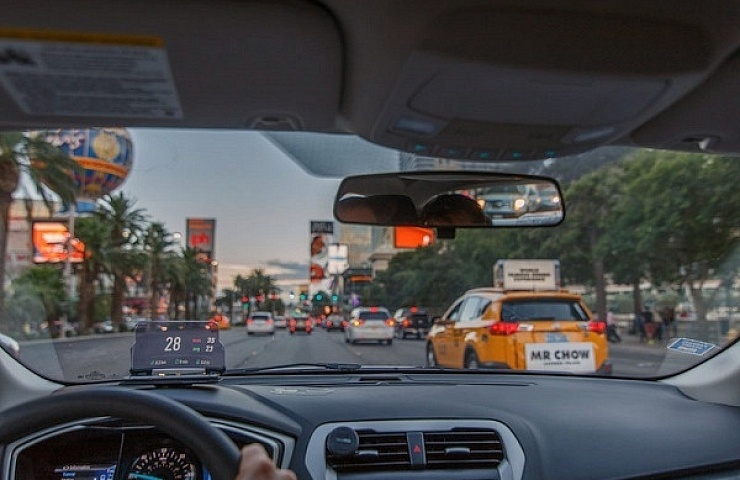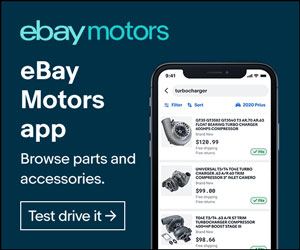April is Distracted-Driving Awareness Month, a program of the National Safety Council. Despite tougher laws, the use of smartphones while driving remains a major health hazard—with increasing number of drivers injured or killed by distraction. One solution is a head-up display (HUD), a technology first used in aviation.
A HUD presents useful vehicle information—and, in some cases, data from your phone—directly in the driver’s line of sight. With a head-up display, the driver can take in a range of information without taking his or her eyes off the road.
Head-Up Is an Available Add-On
Head-up displays are available in new cars from a growing list of automakers, including BMW, Chevrolet, Ford, Jaguar, Lexus, Mazda, Mercedes-Benz, Mini, Toyota, and Volvo. If your current ride doesn’t offer a HUD, take heart: There are numerous affordable aftermarket head-up products available on eBay Motors.
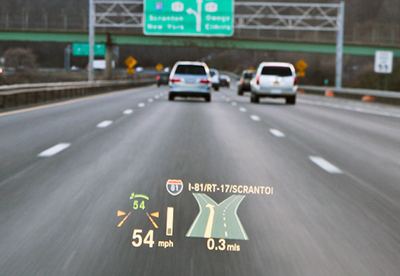
Navigation instructions are helpful and less distracting when presented in a heads-up display.
Aftermarket head-up displays utilize information from your car’s computer system—the type of info usually presented on the dashboard—and project it on or near the windshield exclusively for the driver.
The type of vehicle information includes:
- Vehicle speed
- Fuel level
- Fuel consumption
- Trip mileage
- Outside air temperature
- Engine and water temperature
What’s most helpful in terms of enhancing safety is the head-up display of navigation instructions, such as:
- Turn-by-turn directions
- Speed limit
- Time to destination
The best HUD systems organize this data in a manner that’s easy to understand with a very quick glance. They also offer day/night modes and brightness settings.
The Windshield as Cockpit
While some HUDs project information directly on the windshield, the best (and usually the most expensive) types of HUDs use a built-in small transparent screen that floats the information in the driver’s line of sight—almost as if it’s hovering above the road. HUDs with a transparent screen tend to have better resolution and brightness.

The simplest HUD uses a phone cradle and a mirror to display navigation guidance.
Most HUDs use a connection to the on-board diagnostics (OBD) port under the dashboard to access vehicle data. The OBD port is a standardized female 16-pin connector, installed under the steering column of all cars sold in the United States after 1996. It was originally designed to support emissions testing.
These HUD units provide a “dongle,” a device about the size of a pack of gum, which snaps into the diagnostic port.
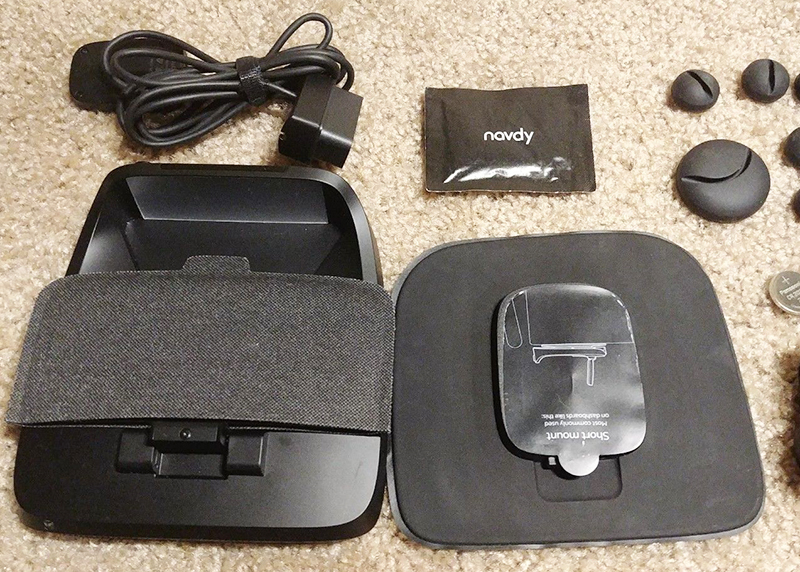
The Navdy system includes a dongle (the item on the top left), which uses a wire to transmit data from the vehicle’s computer to the head-up display.
Dedicated versus Tethered Displays
These dedicated units provide navigation and turn-by-turn directions without connecting to a phone. Dongles are usually wireless, transmitting data pulled from the OBD to the HUD itself. They can also connect to smartphones via Bluetooth, although the lower-priced products use a wire that’s run in the dashboard seams.
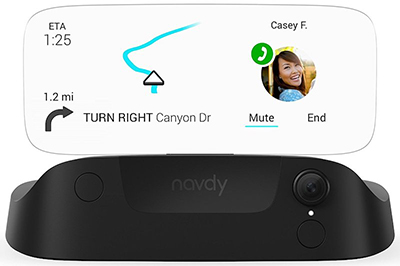
Navdy is a leading HUD product with robust features.
The latest generation of HUD technology harnesses the power of smartphones and utilize apps to power the information in the display. Because the data and its processing capability come from your phone—and are not built into the HUD unit—these are usually less expensive.
But the bigger advantage of integrating the HUD with a smartphone—either iOS or Android—is the ability to display text messages and information about incoming calls.
With smartphone voice features like Siri and Hey Google, you can even safely take calls and send/receive texts via voice and hands-free—again, without taking your eyes off the road. (Of course, to completely avoid distraction, power down your smartphone, stow it away in the glove box, and just drive.)
HUD units usually sit on top of the dashboard and are held securely with either a magnetic or sticky pad. Some have a cradle for your phone, but most of them access data and app functionality via Bluetooth—allowing you to put your phone away.
Because the smartphone is on continuously when using the HUD, it is best to add a power cable to connect to your vehicle’s cigarette lighter or USB charging connector.
Both dedicated and smartphone HUDs are portable and can be moved from vehicle to vehicle or safely stored out of sight when not in use.
The added safety and high-tech appeal of a HUD is hard to resist. Get started with adding this feature by visiting eBay Motors to peruse the wide selection of head-up displays.

